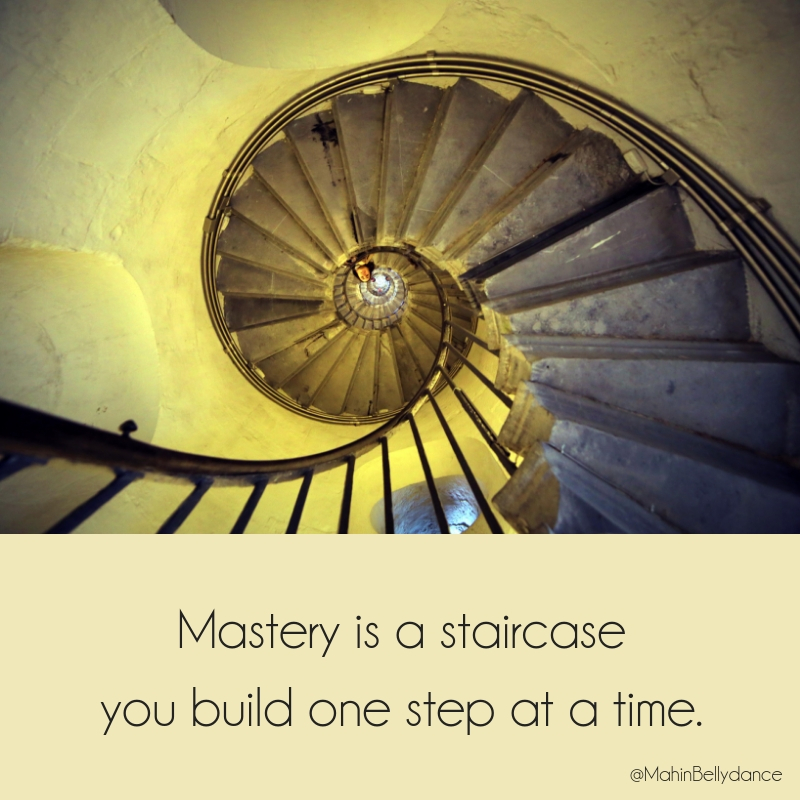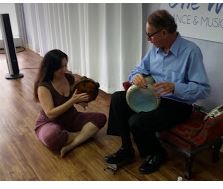Build Your Staircase: What Learning Riq Reminded Me About Belly Dance

Remember back to your first few month of bellydance class – or maybe you are still in those first few months! Every week you are presented with a few new places to try to coax your hips to go. Some are easier than others. One side works better than the other. That’s the way it is for pretty much everyone.
The first 6 to 9 months of bellydance is really building your foundation. Good posture, clean hip directions, moving from the right muscles, learning rhythms. It’s so tempting to cheat sometimes – like when your teacher tells you to keep those heels down for your mayas – it’s just so much easier with your heels off the floor. Or you’re advised not to “side-swipe” your zills. Why? Why do you have to? It sounds fine. It looks right enough. Does it really matter?
It really does. Building quality foundation movements and good technique can be frustrating at first and feels like such a slow process. I remind beginner students often that “fundamental” doesn’t mean “easy”, it means important. Like the foundation of a house, everything you build on top of it will be made better by a solid base. In Peak: Secrets from the New Science of Expertise , a book on skill acquisition by Anders Ericsson, he describes the path to mastery as a stairway you build as you go. You build the next step, then you stand upon it to build the one after it. What a perfect metaphor!
It’s been a good two decades since I’ve been a beginner dancer, but I have recently started seriously learning to play the riq. I am most definitely a beginner at that. I had a moment that really brought it all back for me.
When you play rhythms on the Arabic tambourine, you play the “tek-ka-teks” by alternating your left and right ring fingers on the bottom cymbals. My teacher, Gaby Tawil, is excellent – he’s a walking rhythm encyclopedia with a discriminating ear. I know he showed me to play the pattern with a left-right-left and I tried. When I kept fumbling and couldn’t keep up with the group, I found myself falling into a right-left-right pattern – but it was working and I was keeping up. And I thought it wouldn’t matter as long as the sound was on time.
Everything was fine for a while… till it wasn’t.
2 months later, Gaby showed me a fancy new pattern to play on top of the drum line. It was so cool and I was very excited that he thought I was ready for it. I had to move quickly from the cymbals to the main surface of the riq repeatedly. My hand couldn’t get back and forth in time and the whole pattern was falling apart even though I could understand it and hear what it should sound like in my head. I took a minute to walk it back and pull it apart – analyzing the problem as a movement issue just as I would do with a student struggling with a walking 3/4 shimmy.
The answer was left-right-left. If I didn’t play it that way, I wasn’t going to get my right hand to the next place on time. The technique point I glossed over and thought was fine came back and bit me hard. I have now added left-right-left finger drills to my practice list since this is clearly a weak link. Two steps forward, one step back – lesson learned.

It’s just like that with dance fundamentals too. The student that fakes their way through hip ups will struggle with all the movements that bring the hip up as part of a more complex pattern or shape – and there are many.
Time spent on the fundamentals of bellydance may not be glamorous or exciting, but it is absolutely essential to long term progress. That first flight of stairs that you build as a beginner lead to everything you can climb to beyond. So take your time and do your drills, knowing that you are laying the foundation of your future dance successes!

